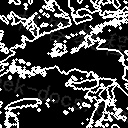在进行大津二值化之后,计算图像的形态学梯度吧。
形态学梯度为经过膨胀操作(dilate)的图像与经过腐蚀操作(erode)的图像的差,可以用于抽出物体的边缘。
在这里,形态学处理的核N=1。
python实现:
import cv2
import numpy as np
import matplotlib.pyplot as plt
# Read image
img = cv2.imread("imori.jpg").astype(np.float32)
H, W, C = img.shape
# Otsu binary
## Grayscale
out = 0.2126 * img[..., 2] + 0.7152 * img[..., 1] + 0.0722 * img[..., 0]
out = out.astype(np.uint8)
## Determine threshold of Otsu's binarization
max_sigma = 0
max_t = 0
for _t in range(1, 255):
v0 = out[np.where(out < _t)[0]]
m0 = np.mean(v0) if len(v0) > 0 else 0.
w0 = len(v0) / (H * W)
v1 = out[np.where(out >= _t)[0]]
m1 = np.mean(v1) if len(v1) > 0 else 0.
w1 = len(v1) / (H * W)
sigma = w0 * w1 * ((m0 - m1) ** 2)
if sigma > max_sigma:
max_sigma = sigma
max_t = _t
## Binarization
#print("threshold >>", max_t)
th = max_t
out[out < th] = 0
out[out >= th] = 255
# Morphology filter
MF = np.array(((0, 1, 0),
(1, 0, 1),
(0, 1, 0)), dtype=np.int)
# Morphology - erode
Erode_time = 1
erode = out.copy()
for i in range(Erode_time):
tmp = np.pad(out, (1, 1), 'edge')
for y in range(1, H+1):
for x in range(1, W+1):
if np.sum(MF * tmp[y-1:y+2, x-1:x+2]) < 255*4:
erode[y-1, x-1] = 0
# Morphology - dilate
Dil_time = 1
dilate = out.copy()
for i in range(Dil_time):
tmp = np.pad(out, (1, 1), 'edge')
for y in range(1, H+1):
for x in range(1, W+1):
if np.sum(MF * tmp[y-1:y+2, x-1:x+2]) >= 255:
dilate[y-1, x-1] = 255
out = np.abs(erode - dilate) * 255
# Save result
cv2.imwrite("out.jpg", out)
cv2.imshow("result", out)
cv2.waitKey(0)
cv2.destroyAllWindows()
输入:

输出:

 极客教程
极客教程